There are currently 1.14 billion websites online, with 252K new websites being created every day. Each one has different goals and caters to its own unique group of users.
From simple blogs sharing information to massive eCommerce stores selling popular products and business websites serving their customers - there are a lot of options to choose from when deciding what type of website you want to build.
It only makes sense that we should sort them into different types to make it easier to determine the right website to choose.
In this article, we look at the 10 most popular types of websites you can create, with a few examples to give you inspiration.
Without further ado, let’s dive right in.
1. Blog Website
A blog is an informational page or online journal that is regularly updated with new content. Whenever new posts are added, they appear at the top of previous posts in reverse chronological order.
Blogs are typically written in a laid-back, conversational style and can be run by individuals or a group of people.
Some popular types of blogs include:
- Food blogs
- Travel blogs
- Fashion and Beauty blogs
- Health and Fitness blogs
- Finance and Investing blogs
- Lifestyle blogs
A blog is a great way to make money online because you can monetize it in a number of ways, including ads, affiliate marketing, digital/physical product offerings, subscriptions, coaching/consulting services, and more.
Even if your website isn't a blog specifically, this is still a handy feature to add to your website as a way to garner more interest and boost authority. For example, a business can add a blog to its website as a way to promote its products and reach more customers.
A blog can also be used as a way to share entertaining and interesting content in order to boost brand awareness.
Features of a Blog Website
There are certain features that every website needs, such as great web design, user-friendly navigation, and clear calls to action. A blog requires additional features to make it more effective for your target audience.
These include things like:
Fresh Content: Your blog should be regularly updated with fresh, engaging content organized into well-defined categories.
Attention-Grabbing Headlines: There is a science and art to naming your blog posts, and you should understand this in order to entice more readers to click and read your posts.
Internal and External Linking: Internal linking ensures intuitive navigation between relevant posts. External linking is a promotional strategy that will provide an enhanced reading experience and help ensure the success of your content online.
Examples of blog websites:
- The Verge
- Wired
- Billboard
- TechCrunch
- Gizmondo
2. eCommerce Website
An eCommerce website is one that sells products or services online. It can be owned by a single business, or the website can be a gateway that allows multiple vendors to showcase their products in an online store.
Either way, this channel provides customers with a convenient way to buy online thanks to features such as search, filter, easy payments, integrated shipping methods, and more.
Features of an eCommerce Website
As previously mentioned, there are certain features that every website needs. These include features like great site design, a strong brand identity, and high-quality content.
However, an eCommerce site also needs to have the following elements:
Robust Security: This is an extremely important feature on a website where visitors enter sensitive information such as credit card details.
Easy Navigation: If you sell a lot of different products on your website, it's important to make it as easy as possible for your customers to find what they're looking for.
A Great Mobile Experience: With more and more people browsing on their mobile devices, mobile-friendliness is a crucial feature that increases customer potential for eCommerce businesses.
Example of an eCommerce Website: Zeuss

This is an eCommerce website with a fantastic design, great products, and strong messaging. It’s a great example of an online store that meets all the criteria for a successful eCommerce site.
Other examples of eCommerce websites:
- eBay
- Amazon
- Walmart
- Alibaba
- Etsy
3. Business Website
A business website is a generic site detailing different areas of a business. Some business sites are aimed at serving customers while others are designed for providing information on the business, product, or brand.
For instance, a business can have a brochure website, which is a type of site that consists of one or two pages displaying basic information on the company, product, or service.
Alternatively, a business might create a full-featured website to showcase every aspect of its product or service, including a blog to provide information on how users can get the most out of their purchase.
Features of a Business Website
While all websites should have great design and compelling content, a business website needs specific elements in order to be successful. These include things such as:
- A clear purpose or goal
- Strong branding
- Simple navigation
- Strong call to action (CTA)
- Prominent contact information
Example of a Business Website: Verpex
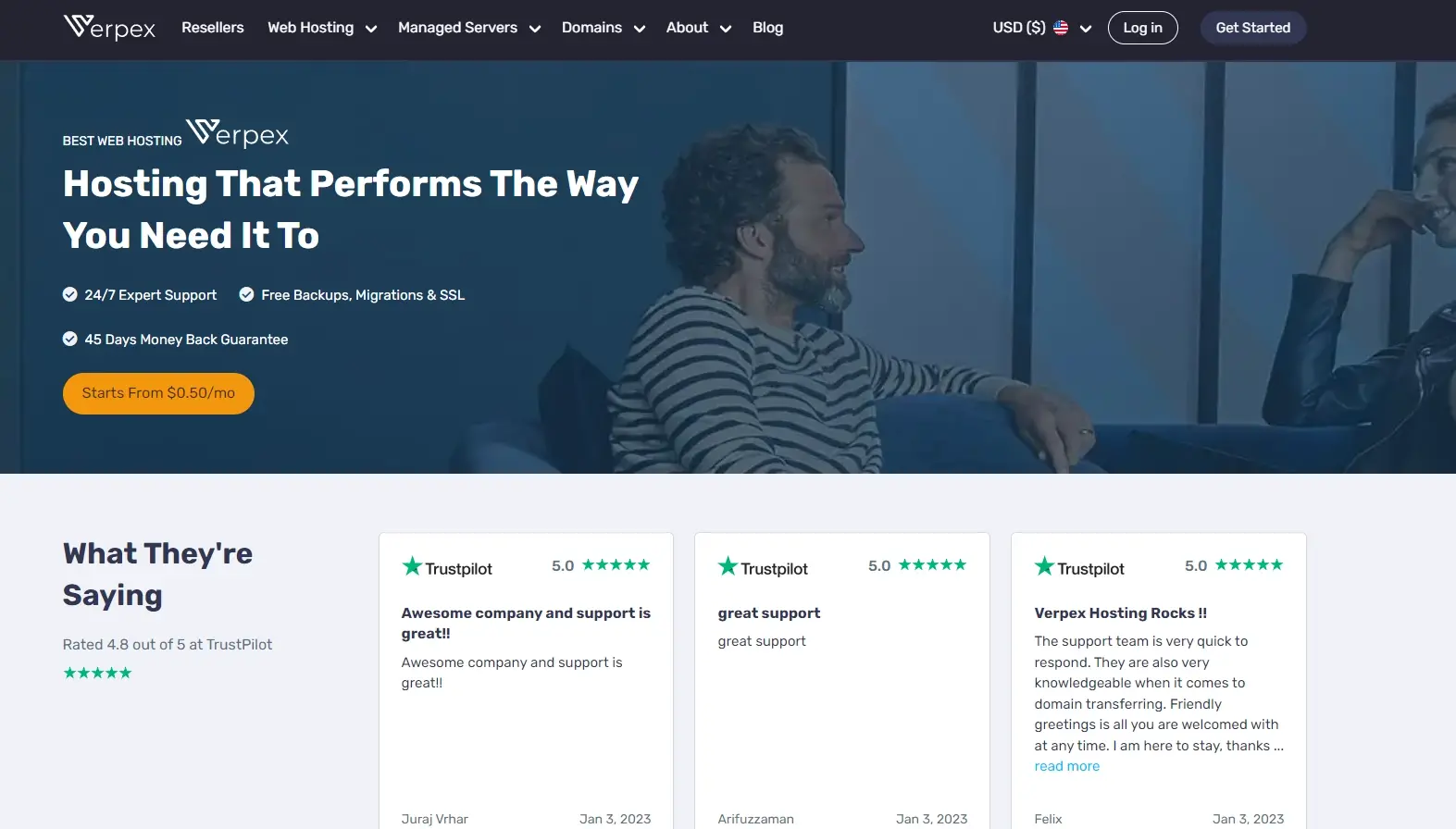
Verpex is a web hosting provider that offers affordable web hosting services for all types of users. The company’s website has a visually engaging design that includes pleasing colors and scroll-triggered animations. On the homepage, there are testimonials, case studies, and other data to show how the business yields real results for clients. This is a great example of a business site designed to showcase its offering to the public.
Other examples of business websites:
- The Balloon Queen
- Kraftful
- Moniker
- Patty and Bun
- Upmind
- The People vs Coffee
4. Personal Website
A personal website is one that's created by an individual with content of a personal nature. For example, someone might create a blog or portfolio to share hobbies or design inspiration with family and friends.
Alternatively, a professional might create a personal website as a sort of “online resume” to display their work experience and skills.
These types of websites allow you to represent yourself online while having full control over the information you share.
Features of a Personal Website
If you want to use a personal website to bolster your online presence, make sure it includes the following features for a polished result:
An About Page: Include an About page with information about yourself, why you created your website, and what you hope to achieve with it.
A High-Quality Image of Yourself: On your Home/About page, make sure to use a high-quality photo of yourself that is clear and doesn't contain other people in it.
Contact Information: Make sure you include information about where visitors can find you around the web and offline (if necessary).
Example of a Personal Website: Andy Martin

Andy Martin is a trombonist from Los Angeles that's been heard on over 150 major motion picture soundtracks. His website has information on his albums, soundtracks, and performances, as well as his career teaching at USC Thornton School of Music.
Other examples of personal websites:
- The Beast is Back
- Albino Tonnina
- Devon Stank
- Daniel Grindrod
- Side Hustle Nation
5. Portfolio Website
An online portfolio is a website used by professional individuals to display creative work. It's similar to a personal website but goes a step further by allowing you to generate more online awareness of your name and work.
This type of website is perfect for artists, designers, photographers, writers, and other creatives. It's the perfect channel to market yourself as a professional or freelancer and showcase your work to gain more attention from potential customers and future employers.
Features of a Portfolio Website
If you want to get your name out into the world, then your portfolio website must have the following features for it to serve as an effective CV or online resume:
Prominent Branding: Make sure your portfolio website includes brand-aligned colors and styles, as well as a memorable logo to increase recognition of your brand.
High-Quality Images: In addition to a clear description of the services you provide, make sure to include a gallery of high-quality images as well.
Social Proof: Add client testimonials, stories, reviews, or case studies to help foster a sense of trust with your website visitors.
Example of a Portfolio Website: Gary Vaynerchuk

Gary Vaynerchuk is a popular public speaker and New York Times best-selling author. His portfolio website has all the necessary features: a high-quality image, prominent branding, and social proof. It also includes a short video montage with information about his life and quick mentions of his accomplishments and skills.
Other examples of portfolio websites:
- Yasio
- Robert Lawler Photography
- Ben Darby
- Charlie Horner Design
- Michael Langley Architecture
6. Educational Website
An educational website is one that provides information and resources on any specific topic(s). The term "educational" covers a wide range of websites, including School/college/university websites, online course sites, and LMS (learning management system) sites. Wiki websites and podcast websites also fall under this category.
Features of an Educational Website
Websites in the educational sector make use of a variety of different media, including articles, videos, images, games, quizzes, etc. to educate audiences. Whether these sites are geared toward adults or children, they often have the following key characteristics in common:
Intuitive Search Functionality: It's important to ensure that visitors can find the information they're looking for as quickly as possible.
Integration with CRM: An educational website needs to have a content management system that is easy to use.
Engaging Content: Although high-quality content is crucial for any website, educational sites need highly engaging content to maintain the interest of learners and boost completion rates.
Example of an Educational Website: Skillshare
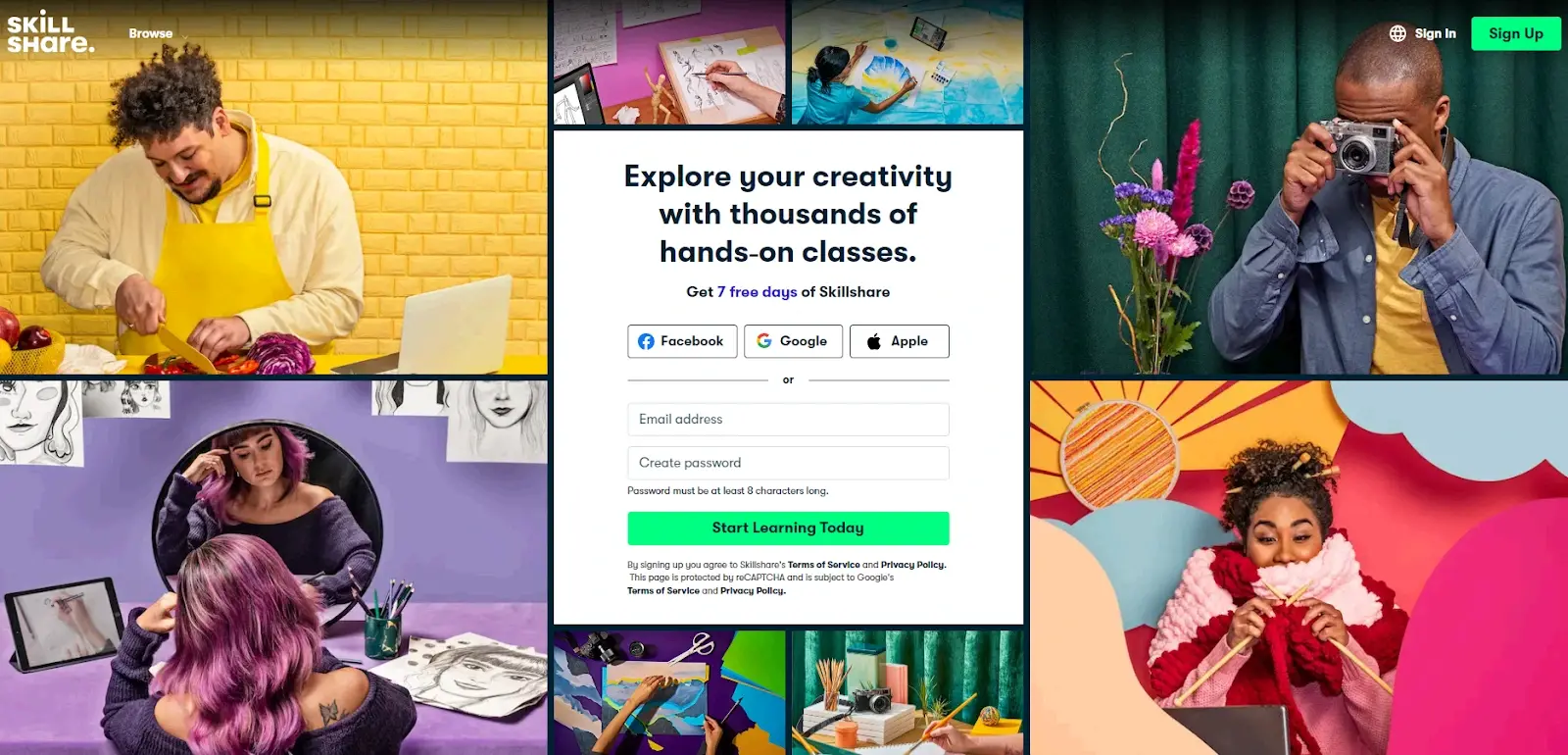
Skillshare is a website that allows people to learn and exchange knowledge with others. The website encourages immediate interaction from visitors by showcasing a strong call to action to "Get Started for Free".
Other examples of educational websites:
- Google.com
- YouTube.com
- Schoology.com
- Typing Agent
- Bio-Med Science Academy
7. News Website
A news website is a portal for publishing news on the web. For the most part, media organizations like newspapers, radio, TV channels, etc. create news websites to serve as an expansion of their service. However, some news websites are on their own.
Since their inception, these types of websites have been a faster and more effective way to deliver local or world news to readers.
These types of websites primarily focus on covering issues related to current affairs, politics, events, sports, and weather. Similar to entertainment websites, they also cover trending topics, which is why there's often overlap between the two types of websites.
The main methods of monetization for news websites are ads and paid subscription models.
Features of a News Website
Although vital to any type of website, the following features are especially important for news and magazine websites.
Social Media Share and Embeds: Social media integration offers a huge opportunity to connect with a broader audience of potential customers. Make sure it's easy to embed content from other platforms so you can add value to your news website.
Easy Administration: A news website needs a CMS with a user-friendly interface to make it easier to manage the process of content production and collaboration.
Image Optimization: Today's consumers prefer visual content to text. Make sure to use high-quality, optimized images to make your news content easier to process.
Example of a News Website: BuzzFeed
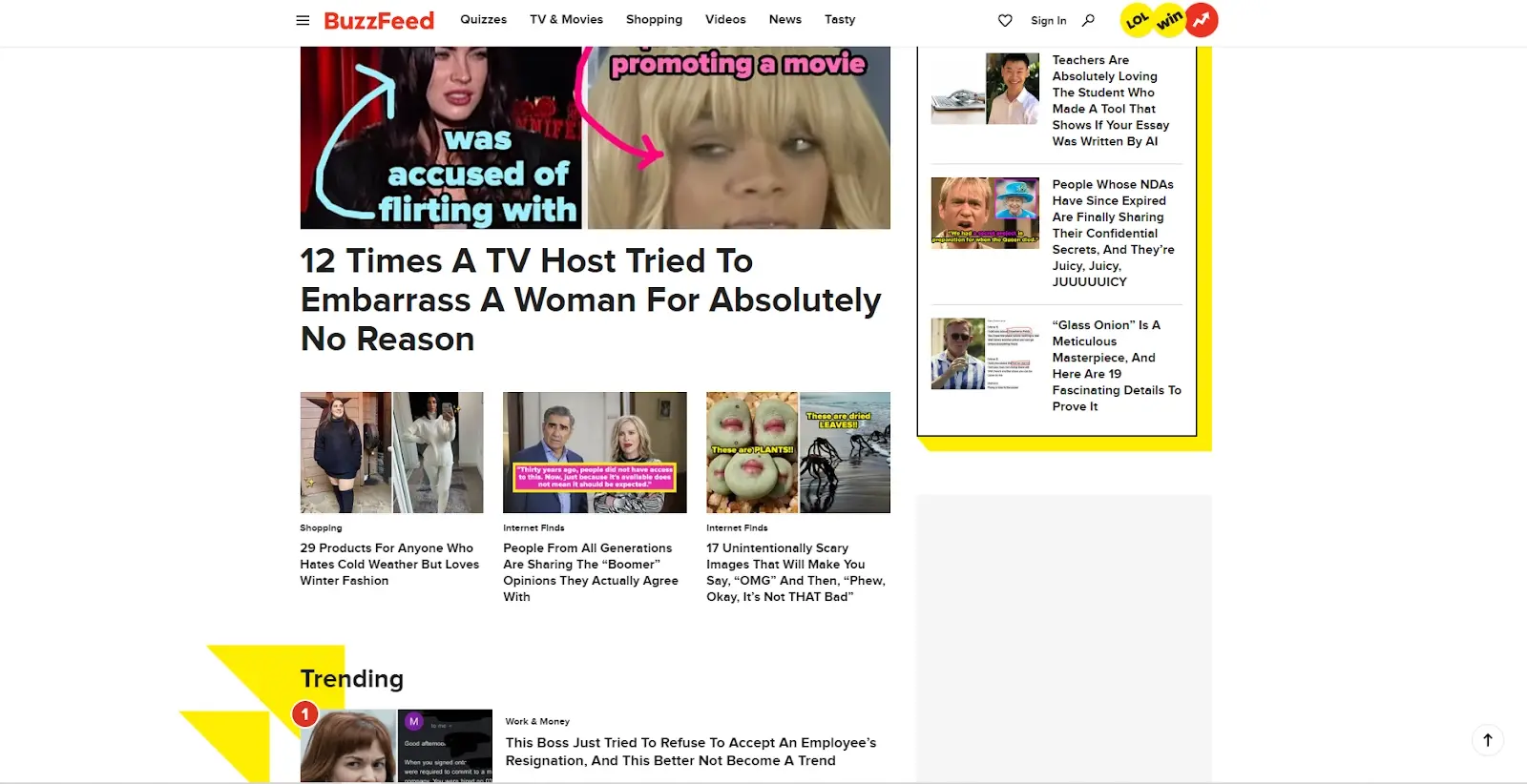
This website offers breaking news and vital journalism, as well as a variety of interesting content and trending buzz such as quizzes, videos, recipes, and celeb news.
Other examples of news websites:
- Time.com
- The Washington Post
- BBC
- CNN
- The Daily Telegraph
8. Entertainment Website
An entertainment or media website is one that offers content on things like sports, movies, current affairs, weather, gaming, etc. It's regularly updated with high-quality, engaging content (blog posts, videos, films, news, etc.) relevant to the website's target audience.
There are many reasons why this type of website is so popular. For one, entertainment is a crucial factor in life. It refreshes the mind and can help to preserve mental health and emotional well-being.
Magazine websites fall into this category, together with gaming portals, movie streaming or downloading websites, podcast websites, and music websites. Some educational, news, or podcast websites also fall into the entertainment category, such as Spotify, Daily Motion, Bored Panda, and more.
While the main goal is to entertain visitors, these types of websites also aim to make money, just like any other business website. Their source of earnings is mainly through advertisements and subscriptions.
Features of an Entertainment Website
There are certain features you need to build a successful entertainment website, including the following:
Dynamic Content: A media website needs dynamic content, which means it should be regularly updated with new articles or videos every day.
User-Friendly Design: The website must look professional and have easy navigation that makes use intuitive and effortless. It must also be mobile-friendly.
Analytics Features: An entertainment website must have the ability to track what's popular so you can stay on top of new trends.
Example of an Entertainment Website: Netflix.com
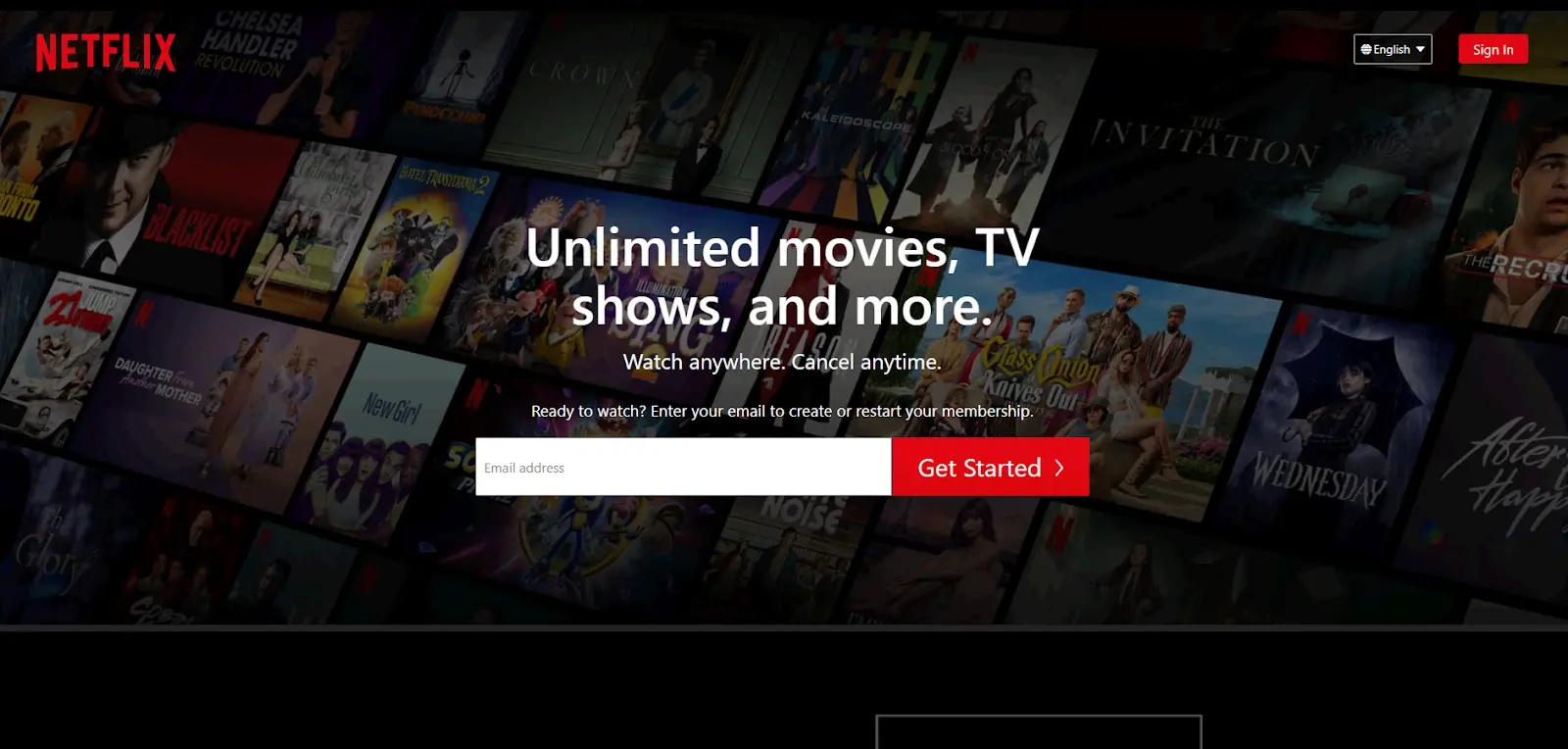
Netflix is an online streaming service where you can find a massive collection of award-winning movies, TV shows, anime, documentaries, and more. New content is added every day to entice users to return more often.
Other examples include:
- Youtube.com
- ESPN
- Fandom.com
- ELLE
- IMDB.com
9. Directory Website
Directory websites play a major role in web promotion by collecting, storing, and showing the top provider names for specific niches in a single place. This makes it easy for potential clients to find the information they're looking for.
They can search by using keywords or other parameters such as company ratings, types of products/services, location, etc.
Features of a Directory Website
You can create many different types of directory websites in a variety of niches like real estate, restaurants, travel, wedding, photography, automotive, events, etc. However, regardless of the type of niche you choose, all directory websites must meet certain criteria.
Here are some of the elements that are important for a directory website.
User-Friendliness: A directory website must provide a curated list that is relevant and easy to explore.
Extended Categories: A quality directory website must have a large number of categories to help users and business owners find relevant services from all available options.
Fast-Loading Pages: The speed of your directory listing website is important in relation to SEO (search engine optimization) and bounce rate.
Example of a Directory Website: Zomato
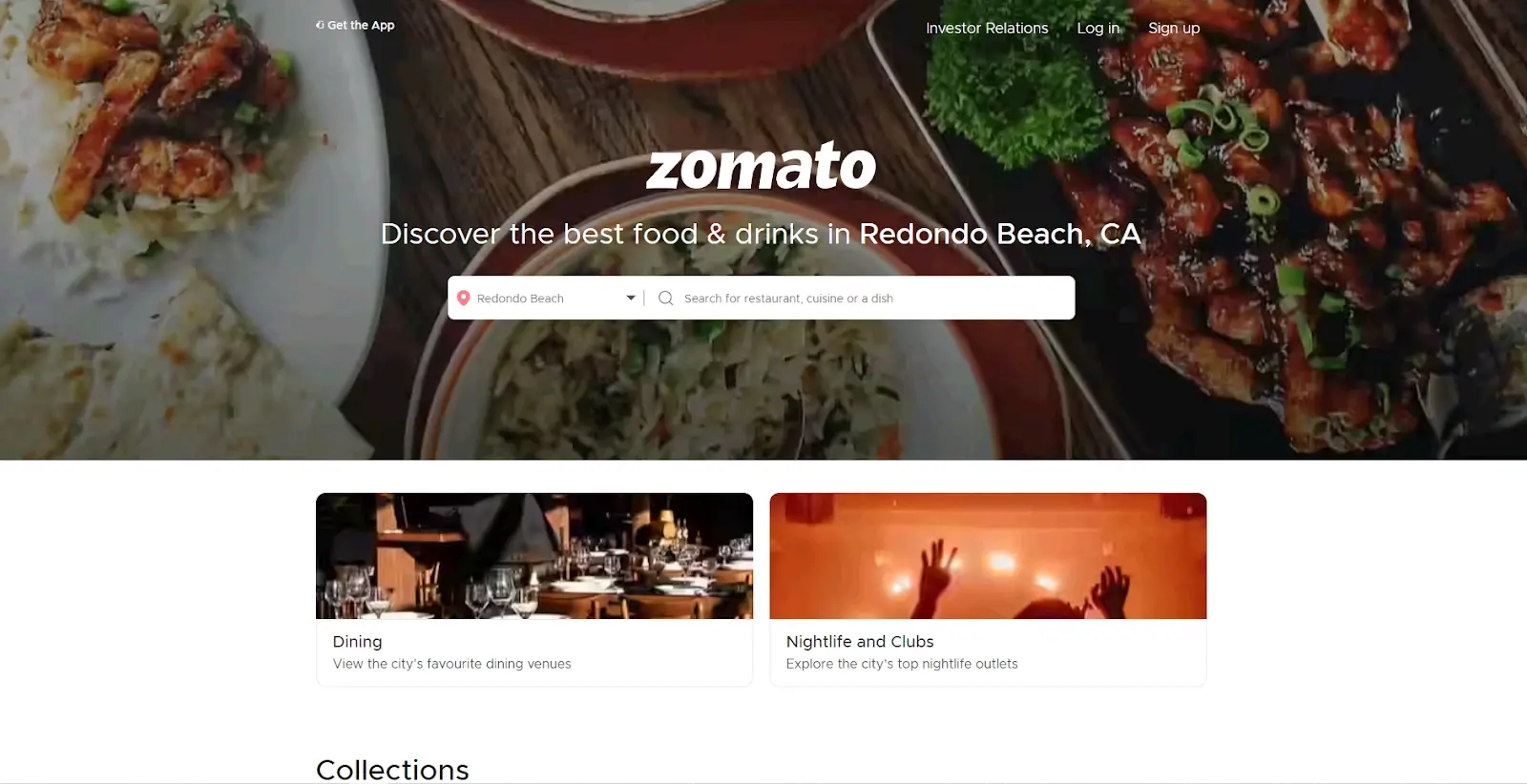
Zomato is a popular restaurant directory website that allows customers to search and discover restaurants in select cities. They can also book a table and order food, as well as read and write customer reviews on the site.
Other examples of directory websites:
- Zomato
- Zillow
- Yelp
- Google Business Profile
- Chamber of Commerce
10. Membership Website
A membership website is a gated portal that includes members-only content. These types of websites are typically used by businesses, companies, universities, organizations, non-profits, clubs, and associations in order to provide additional value to their members.
There are various types of membership sites you can create. Here’s a quick look at some of the most common types:
Content Library: Netflix is a great example of this type of website which gives you full access to the entire content library as soon as you subscribe.
Drip Feed: This model is most often used by online courses that release lessons based on either a set schedule or learner progress.
Product Combo: This model combines a membership website with a product. For example, a vegan meal kit subscription could come with a members-only section of the website that includes videos on bulk cooking and ideas for how to use leftovers to prevent waste.
Service Website: A service website allows members to access specific services, such as graphic design, content creation, coaching, consulting, etc. The subscriber pays for the service, not the content. By logging into the member's area, members can schedule or request services and download additional resources, such as eBooks, worksheets, etc.
Community Website: Rather than selling access to content, this type of website offers access to a community such as an exclusive social media group or online forum that connects people of shared interests. This is a perfect website model for anyone who wants to launch a membership site without investing in lots of content development.
Membership sites offer a subscription model (free or paid) that allows members to access information on the site by logging in.
Different levels of membership determine the type of information users can access. For instance, on an educational membership website, learners will be able to access lessons, schedules, results, etc., whereas instructors will have access to information related to management and administration, such as student performance records and teaching strategies.
Features of a Membership Website
The structure of a membership website is typically more complex than other types of websites. The majority of online website builders may not provide all the essential tools to develop a full-featured membership website, which is why you may need to use a plugin or third-party membership platform.
Regardless of which avenue you choose, your membership site must have the following features:
Multiple Membership Levels: With multiple membership levels, you'll be able to offer your audience custom packages that best suit each individual's needs and budget.
Member Management Tools: A membership website requires robust customer management features that allow you to track important growth metrics like new members, growth rates, lifetime member value, and more.
Payment Processing System: If you want to receive online payments on your website, then you need a reliable payment gateway that's directly linked to your membership management software.
Example of a Membership Website: Gaia
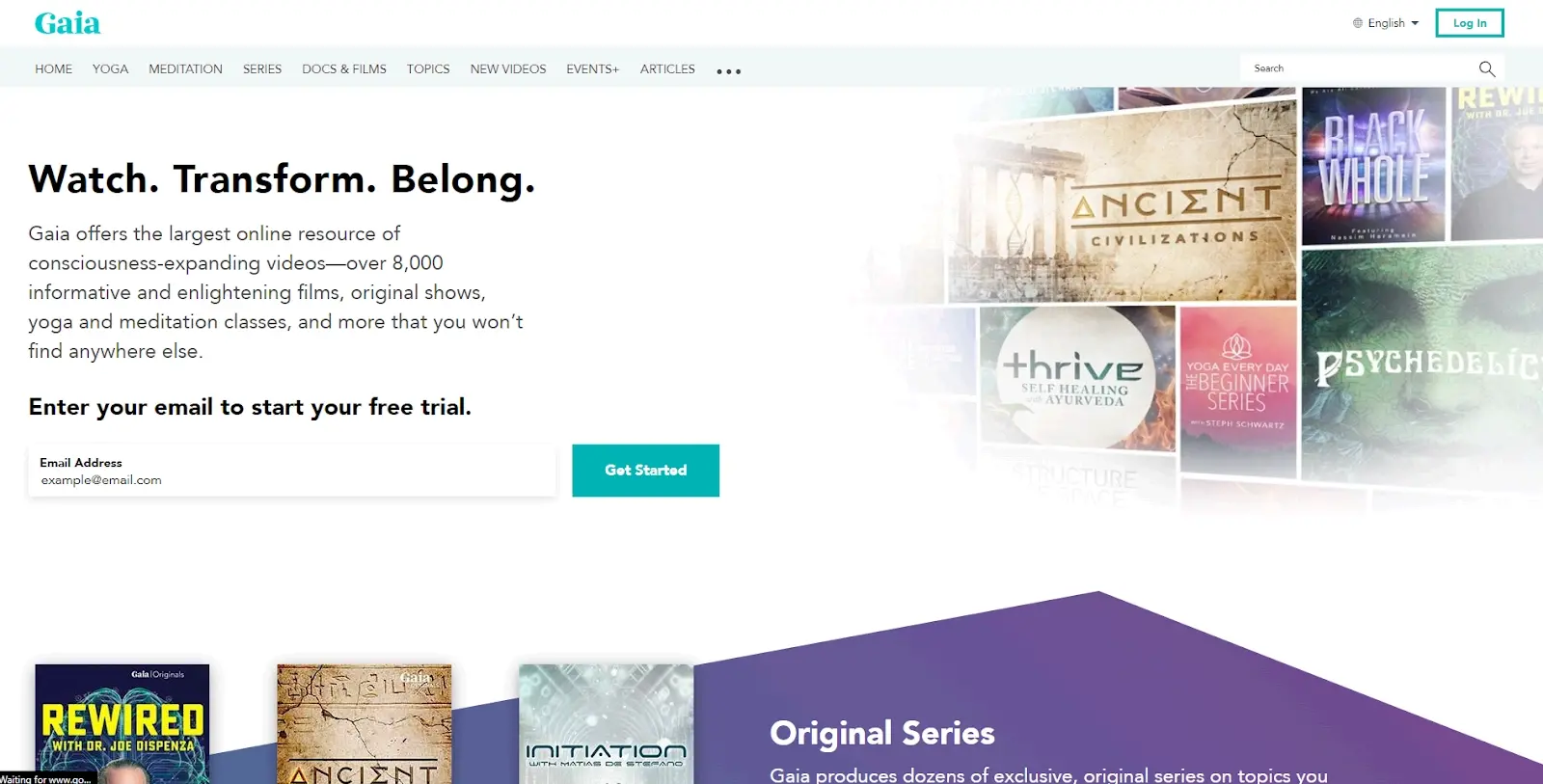
This website offers a huge online resource of enlightening films and consciousness-expanding videos. Different levels of membership offer different tiers of content access.
Other examples of membership websites:
- Boooooom
- 30-day Singer
- Udemy
- GuitarZero2Hero
- Price Action Traders Academy
Conclusion
This is by no means an exhaustive list of the most popular types of websites. It’s beyond the scope of this article to mention them all, so I merely picked the 10 most commonly used ones.
Other types of websites include job board websites, social networking sites, search engine websites, non-profit/charity websites, crowdfunding websites, and many more.
Use this list to help you determine which type of website is right for your next project.
Has this article helped you determine which type of website will help you bring your ideas to light? Let me know in the comments below!
Frequently Asked Questions
Are website builders easy to use?
One of the easiest ways to build a website is with a website builder. Using a website builder doesn't require any programming and coding skills.
Can I afford a website builder?
Yes. Besides paid website builders, there are also free ones; however, they come with fewer options.
Is a website on WordPress safe?
Websites on WordPress are safe, however to avoid hacking keep your website up to date.
Why should I create a website?
There are many reasons why you should create a website if you’re an artist. You can use it to create a place where people can learn about you, talk about your art, or show off your work.

Ron Stefanski is a website entrepreneur and marketing professor who has a passion for helping people create and market their own online business. You can learn more from him by visiting OneHourProfessor.com
View all posts by Ron Stefanski




















